

Bloom's Digital Taxonomy Video. Tap here for our Free App!
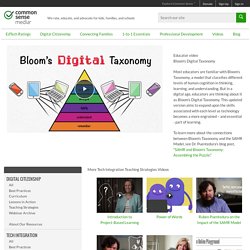
Get all our media picks, personalized for your kids. No thanks Jump to navigation Discover the best apps, games, and websites and learn best practices forteaching with technology. Mute. Numérique Éducatif. Le modèle SAMR établi par Robert Puentedura peut-être particulièrement efficace aujourd’hui pour estimer l’impact des technologies numériques dans l’enseignement, à condition qu’il soit interprété, au plus près des intentions de l’auteur.
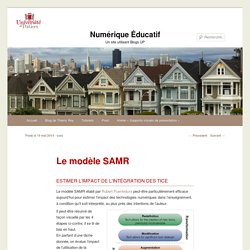
Il peut-être résumé de façon visuelle par les 4 étapes ci-contre, il se lit de bas en haut. En partant d’une tâche donnée, on évalue l’impact de l’utilisation de la technologie en se référant aux 4 niveaux : soit la technologie permet une amélioration (niveaux 1 et 2), soit elle permet une transformation de la tâche (niveaux 3 et 4), laquelle transformation est – d’après Puentedura – source d’un meilleur apprentissage. Voici un exemple 0 : Tâche initiale : Repérer un lieu dans un atlas. 1: Substitution : Utiliser Google Earth pour indentifier les lieux. 2: Augmentation : Utiliser les outils de Google Earth pour mesurer la distance entre deux lieux. 4: Redéfinition : Créer une narration guidée sur Google Earth et la publier en ligne. Compléments. Rethinking SAMR. Last week I had the good fortune of getting to hear Ruben Puentedura speak at the 7th annual 21st Century Learning event out here in Hong Kong.
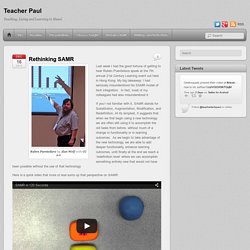
My big takeaway: I had seriously misunderstood his SAMR model of tech integration. In fact, most of my colleagues had also misunderstood it. If you’r not familiar with it, SAMR stands for Substitution, Augmentation, Modification, and Redefinition. At its simplest, it suggests that when we first begin using a new technology we are often still using it to accomplish the old tasks from before, without much of a change in functionality or in learning outcomes.
As we begin to take advantage of the new technology, we are able to add deeper functionality, enhance learning outcomes, until finally at the end we reach a ‘redefinition level’ where we can accomplish something entirely new that would not have been possible without the use of that technology. Here is a quick video that more or less sums up that perspective on SAMR: I asked Dr. Creative Visualizations of Bloom's Taxonomies! Bloomin' Apps. This page gathers all of the Bloomin' Apps projects in one place.Each image has clickable hotspots and includes suggestions for iPad, Android, Google and online tools and applications to support each of the levels of Bloom's Revised Taxonomy.I have created a page to allow you to share your favorite online tool, iOS, or Android app with others.
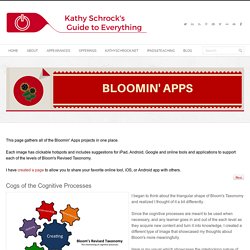
Cogs of the Cognitive Processes I began to think about the triangular shape of Bloom's Taxonomy and realized I thought of it a bit differently.Since the cognitive processes are meant to be used when necessary, and any learner goes in and out of the each level as they acquire new content and turn it into knowledge, I created a different type of image that showcased my thoughts about Bloom's more meaningfully.Here is my visual which showcases the interlocking nature of the cognitive processes or, simply, the "Cogs of the Cognitive Processes".
22 Ways To Use Twitter With Bloom’s Taxonomy. How To Use Pinterest With Bloom's Taxonomy. Blooms, SAMR & the 3 C's - iSupport. All the apps you’ll ever need As I prepared for an upcoming presentation at a local University I unloaded my test iPad of all its applications and created a new iPad, complete only with apps which I use at school every week.
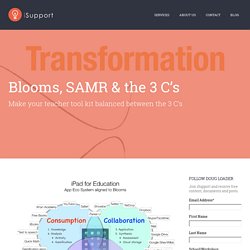
This iPad would become my “essentials” iPad, strategically and efficiently full of apps I wholly recommend to every educator I meet. I went through the apps and I developed a list, indicating the apps purpose. I found that these purposes consistently fell into 3 categories: Consumption, Creation and Collaboration. I found I had many educational gaming type apps (gamification of learning) which fitted into the Consumption category. Today I chose to focus on these 3 “C’s” activities, and it was clear that they could be easily aligned to Blooms Taxonomy objectives. When you are considering your teaching tool kit, consider a concise balance between these apps. Ipadagogy-wheel-001.jpg (JPEG Image, 1403 × 1044 pixels) - Scaled (72%)
Blooms Digital Taxonomy. MNPS Digital Bloom's Poster - MNPS Bloom's Digital Taxonomy. Setting learning outcomes - Staff - Macquarie University. Following the principle of constructive alignment (see curriculum design) we need to be able to describe learning outcomes that our students can achieve and that are capable of being assessed.

Learning outcomes are the specific intentions related to what students should know, understand or be able to do. They are often described as discipline specific (related to the subject) or generic (related to certain skills such as presentation). Outcomes should be explicit and intelligible to students and other users, expressed in such a form that permits their achievement to be demonstrated.
When related to a program of study, outcomes should ideally be developed with reference to relevant forms of external information such as benchmarks or other frameworks.